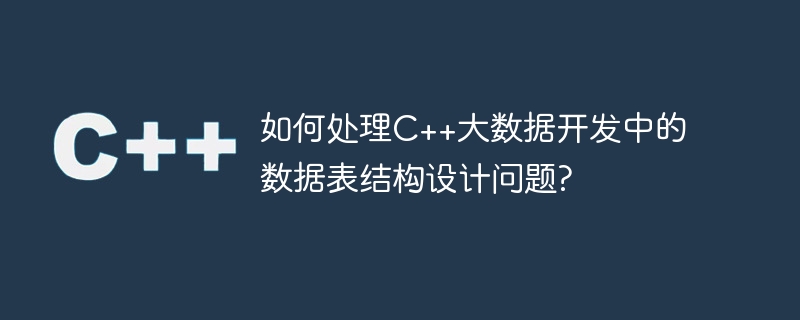Home >Backend Development >C++ >How to deal with data table structure design issues in C++ big data development?
How to deal with data table structure design issues in C++ big data development?
- 王林Original
- 2023-08-25 16:31:511018browse

How to deal with the data table structure design problem in C big data development?
In C big data development, data table structure design is a very important link. Good data table design can improve program performance, reduce resource usage, and also improve code readability and maintainability. This article will introduce some methods to deal with data table structure design issues in C big data development, and illustrate it through code examples.
1. Data table structure design principles
- The table name should be concise and clear: the table name should be able to clearly describe the meaning of the data and be as concise and clear as possible. Avoid using table names that are too long or complex.
- Field naming specifications: Field naming should follow certain specifications to facilitate developers' understanding and use. CamelCase or underscore notation may be used, but consistency is required.
- Selection of primary keys and indexes: For the primary keys of data tables and fields that need to be frequently queried, you should consider adding indexes to improve query efficiency.
- Choose appropriate data types: Choose appropriate data types based on actual needs and avoid excessive use of large data types to save storage space and improve performance.
- Standardized design: Follow the standardized design principles of the database, decompose the data into the smallest logical units, and reduce data redundancy and data insertion and update anomalies.
2. Sample code: student information table
In order to better illustrate the problem of data table structure design, here we take the student information table as an example to demonstrate how to design according to the above principles data sheet.
#include <iostream>
#include <string>
#include <vector>
using namespace std;
// 学生信息表结构体
struct Student {
int id; // 学号
string name; // 姓名
int age; // 年龄
float score; // 成绩
};
// 数据表类
class StudentTable {
private:
vector<Student> data; // 数据表
public:
// 添加学生信息
void addStudent(int id, string name, int age, float score) {
Student stu;
stu.id = id;
stu.name = name;
stu.age = age;
stu.score = score;
data.push_back(stu);
}
// 根据学号查询学生信息
Student searchStudentById(int id) {
for (auto stu : data) {
if (stu.id == id) {
return stu;
}
}
Student emptyStu;
emptyStu.id = -1; // -1表示未找到
return emptyStu;
}
// 根据姓名查询学生信息
vector<Student> searchStudentByName(string name) {
vector<Student> result;
for (auto stu : data) {
if (stu.name == name) {
result.push_back(stu);
}
}
return result;
}
// 删除学生信息
void deleteStudent(int id) {
for (auto it = data.begin(); it != data.end(); ++it) {
if (it->id == id) {
data.erase(it);
break;
}
}
}
// 输出学生信息
void printStudentInfo(vector<Student> students) {
for (auto stu : students) {
cout << "学号:" << stu.id << " 姓名:" << stu.name << " 年龄:" << stu.age << " 成绩:" << stu.score << endl;
}
}
};
int main() {
StudentTable table;
// 添加学生信息
table.addStudent(1, "张三", 18, 90.5);
table.addStudent(2, "李四", 19, 85.0);
table.addStudent(3, "王五", 20, 92.5);
// 根据学号查询学生信息
Student stu1 = table.searchStudentById(1);
cout << "学号为1的学生信息:" << endl;
table.printStudentInfo(vector<Student>{stu1});
// 根据姓名查询学生信息
vector<Student> result = table.searchStudentByName("张三");
cout << "姓名为张三的学生信息:" << endl;
table.printStudentInfo(result);
// 删除学生信息
table.deleteStudent(2);
// 输出剩余学生信息
cout << "剩余学生信息:" << endl;
table.printStudentInfo(table.data);
return 0;
}The above code demonstrates how to use structures and classes to represent and operate student information tables. Through functions such as adding, querying, and deleting, we can easily operate the data in the student information table. At the same time, the functions of the class can also be further expanded according to actual needs.
Through the above examples, we can see that good data table structure design can improve the readability and maintainability of the code, while also improving the performance of the program and reducing resource usage. Proper use of techniques such as data types, standardized design, and adding indexes can better handle data table structure design issues in C big data development.
The above is the detailed content of How to deal with data table structure design issues in C++ big data development?. For more information, please follow other related articles on the PHP Chinese website!
Related articles
See more- C++ compilation error: A header file is referenced multiple times, how to solve it?
- C++ compilation error: wrong function parameters, how to fix it?
- C++ error: The constructor must be declared in the public area, how to deal with it?
- Process management and thread synchronization in C++
- How to deal with data splitting problems in C++ development

